Puntigrus tetrazona
Tiger Barb
SynonymsTop ↑
Capoeta tetrazona Bleeker 1855; Barbus tetrazona (Bleeker 1855); Puntius tetrazona (Bleeker 1855); Systomus tetrazona (Bleeker 1855); Systomus sumatranus Bleeker 1860; Systomus sumatrensis Bleeker 1860
Etymology
Puntigrus: formed from part of the generic name Puntius and tigrus, a word created to sound like the Latin word tigris, meaning ‘tiger’, in allusion to the barred colour pattern and the common name ‘tiger barb’ used for some members.
tetrazona: from the Ancient Greek τέτταρες (téttares), meaning ‘four’, and ζώνη (zṓnē), in reference to this species’ colour pattern which comprises four dark vertical bars.
Classification
Order: Cypriniformes Family: Cyprinidae
Distribution
Probably endemic to central and southern Sumatra, with records from Borneo corresponding to congeners. Additional records exist from the Indragiri, Batang Hari, and Musi river systems in Riau, Jambi, and South Sumatra provinces, respectively.
Type locality is ‘Lahat, Palembang Province, Sumatra, Indonesia’ which corresponds to modern-day Lahat Regency in Sumatera Selatan (South Sumatra) province.
Feral populations derived from aquarium stock also exist in a number of other territories including Singapore, Australia, the United States, Colombia, and Suriname.
Habitat
Unconfirmed, but Bornean congeners display a preference for forest streams and tributaries containing relatively clear water and substrates of sand and rocks/pebbles of varying sizes (M. Lo, pers. comm; M. Ford pers. obv.).
Maximum Standard Length
50 – 60 mm.
Aquarium SizeTop ↑
Base dimensions of 80 ∗ 30 cm or equivalent should be the smallest considered.
Maintenance
Choice of décor is not especially critical though it tends to show better colouration in a well-decorated set-up. The addition of floating or overhanging vegetation and driftwood roots or branches also seems to be appreciated.
Water Conditions
Temperature: 20 – 26 °C
pH: 5.0 – 8.0; commercial strains tend to be adaptable, but acidic to neutral conditions are recommended for wild stock.
Hardness: 18 – 357 ppm. Wild fish will do best towards the lower end of this range.
Diet
Probably an omnivore feeding primarily on aquatic invertebrates, as well as smaller amounts of plant material and organic detritus in nature.
In the aquarium it is easily-fed but the best condition and colours offer regular meals of small live and frozen foods such as chironomid larvae (bloodworm), Daphnia, and Artemia, alongside good quality dried flakes and granules, at least some of which should include additional plant content.
Behaviour and CompatibilityTop ↑
This species is notoriously aggressive with a reputation for biting the fins of other fishes, although this behaviour only seems to be pronounced when insufficient numbers are purchased or space is limited.
That said, it is relatively boisterous and does not make an ideal companion for timid, slow-moving, or long-finned species such as many livebearers, cichlids, and anabantoids.
Robust fishes inhabiting similar biotopes in nature, especially comparably-sized, pelagic cyprinids perhaps constitute the best choices but other options include balitorid, cobitid, and nemacheilid loaches as well as benthic cyprinids such as Crossocheilus or Garra species. If geography is not an issue many rainbowfishes and tetras are also suitable, but be sure to research your choices thoroughly before purchase.
It is a gregarious species forming loose hierarchies, with rival males continually battling with each other for female attention and hierarchical position within the group.
A group of at least 8-10 specimens should be considered the minimum purchase since this increases the likelihood that the fish will be distracted by each other rather than their tankmates and will result in a more natural-looking display. Males will also show better colouration in the presence of conspecific rivals.
Sexual Dimorphism
Adult males tend to be smaller, slimmer, and possess a more intense colour pattern than females.
Reproduction
Like most small cyprinids Puntigrus spp. are egg-scattering free spawners exhibiting no parental care.
When in good condition they will spawn often, and in a mature aquarium it is possible that small numbers of fry may start to appear without intervention. If you wish to maximise yield a more controlled approach is required, however.
The adult group can be conditioned together but an additional aquarium should be set up and filled with mature water. This should be dimly lit and the base covered with some kind of mesh of a large enough grade so that the eggs can fall through, but small enough so that the adults cannot reach them. The widely available plastic ‘grass’-type matting can also be used and works well, as does a layer of glass marbles. Alternatively, filling much of the tank with a fine-leaved plant such as Taxiphyllum spp. or spawning mops can also return decent results.
The water itself should be of slightly acidic to neutral pH with a temperature towards the upper end of the range suggested above, and an air-powered sponge filter or air stone(s) should also be included to provide oxygenation and water movement.
When the females appear gravid one or two pairs can then be introduced, and spawning should take place the following morning. A second option is to spawn the fish in a group with half a dozen specimens of each sex being a good number, although a larger aquarium may be necessary.
In either situation the adults should be removed post-spawning. The eggs should hatch in 24 – 48 hours with fry swimming freely around 24 hours later. They should be fed on an infusoria-grade food for the first few days until large enough to accept microworm, Artemia nauplii, or suchlike.
NotesTop ↑
P. tetrazona is traditionally considered to be among the most ubiquitous species available in the aquarium trade. Wild examples are rarely traded, however, and there exists ongoing confusion as to the identity of the commercially-produced ‘aquarium’ tiger barb.
A number of selectively-bred, ornamental strains are available. The albino, ‘green’ (aka ‘moss’), and ‘golden’ (leucistic) variants are particularly popular, but there also exist ‘platinum’, ‘blushing’, ‘black marble’, and ‘coral red’ strains. These have no additional requirements and care is as described above.
Unfortunately, many of the fish traded today are genetically weak, prone to disease, or develop physical deformities due to excessive inbreeding. This species has also been subjected to the abhorrent practice of artificial dying, a cruel and undoubtedly painful process which involves injecting the fish repeatedly with coloured dyes.
P. tetrazona is distinguished from congeners by the following combination of characters: lateral line incomplete; 12 circumpeduncular scales; 19-21+2 scales in the lateral row; dorsal fin mostly black with paler outer margin; pelvic fins black in middle, hyaline at base and tip; dark body bars relatively wide, covering up to 2.5 scales.
The genus Puntigrus was raised by Kottelat (2013) in order to accommodate a group of species formerly referred to as the ‘Puntius tetrazona group’. Other members are P. anchisporus, P. navjotsodhii, P. pulcher, and P. partipentazona, of which the first three are native to western, central, and eastern Borneo, respectively, and the latter to Indochina.
This assemblage is diagnosed by possession of a unique colour pattern comprising 4 black bars on a pale body, and black pigmentation on at least the basal half of the dorsal-fin. The anteriormost body bar passes through the eye, the second is anterior to the pelvic-fin base, the third is above the anal-fin and continues onto it, and the posteriormost is at the caudal-fin base.
The following combination of characters also aid in identification, although individually they are not unique to the genus: body rhomboid, deep; last simple dorsal-fin ray serrated posteriorly; rostral barbels absent; maxillary barbels present; lips smooth and thin, postlabial groove interrupted medially; lateral line complete or incomplete; 18–23 lateral line scales; 9½–10½ [5½/1/3–4½] scale rows between dorsal-fin origin and ventral midline anterior to pelvic-fin base; 12–14 circumpeduncular scale rows; 8–9 rakers on first gill arch.
The genus Puntius was previously viewed as a polyphyletic catch-all containing over 100 species, but this situation has been largely resolved since the turn of the century. Puntigrus tetrazona is referred to as Puntius tetrazona, Systomus tetrazona, or Capoeta tetrazona in older literature.
References
- Bleeker, P., 1855 - Natuurkundig Tijdschrift voor Nederlandsch Indië v. 9: 257-280
Nalezingen op de vischfauna van Sumatra. Visschen van Lahat en Sibogha. - Alfred, E. R., 1963 - Bulletin of the National Museum of Singapore 32: 135-142
Some Colourful Fishes of the Genus Puntius Hamilton. - Collins, R., K. F. Armstrong, R. Meier, Y. Yi, S. D. J. Brown, R. H. Cruickshank, S, Keeling, C. Johnston, 2012 - PLoS ONE 7(1): e28381
Barcoding and Border Biosecurity: Identifying Cyprinid Fishes in the Aquarium Trade - Kottelat, M., 1992 - Raffles Bulletin of Zoology 40(2): 187-192
The identity of Barbus johorensis Duncker, 1904 (Teleostei: Cyprinidae). - Kottelat, M., 2013 - Raffles Bulletin of Zoology Supplement 27: 1-663
The fishes of the inland waters of southeast Asia: a catalogue and core bibiography of the fishes known to occur in freshwaters, mangroves and estuaries. - Kottelat, M. and H. H. Tan, 2011 - Ichthyological Exploration of Freshwaters 22(3): 209-214
Systomus xouthos, a new cyprinid fish from Borneo, and revalidation of Puntius pulcher (Teleostei: Cyprinidae). - Kullander, S. O. and F. Fang, 2005 - Copeia 2005(2): 290-302
Two new species of Puntius from northern Myanmar (Teleostei: Cyprinidae). - Pethiyagoda, R., 2013 - Zootaxa 3646(2): 199
Haludaria, a replacement generic name for Dravidia (Teleostei: Cyprinidae). - Pethiyagoda, R., M. Meegaskumbura, and K. Maduwage, 2012 - Ichthyological Exploration of Freshwaters 23(1): 69-95
A synopsis of the South Asian fishes referred to Puntius (Pisces: Cyprinidae). - Tan, H-H., 2012 - Raffles Bulletin of Zoology Supplement 25: 285-289
Systomus navjotsodhii, a New Cyprinid Fish from Central Kalimantan, Borneo. - Tan, H.H. and M. Kottelat, 2009 - Ichthyological Exploration of Freshwaters 20(1): 13-69
The fishes of the Batang Hari drainage, Sumatra, with description of six new species.
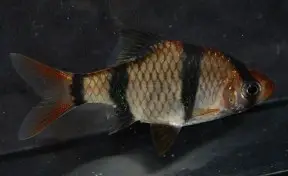
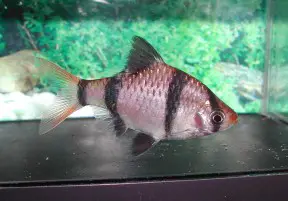
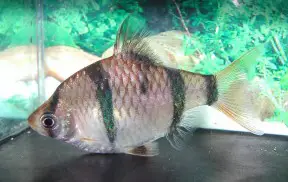

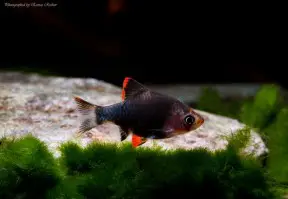
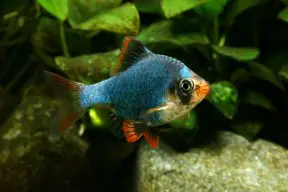
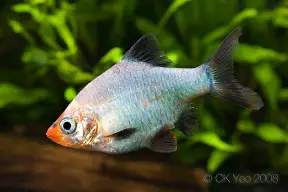
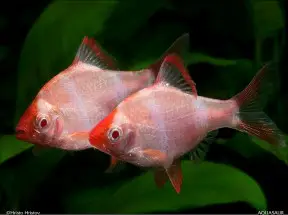
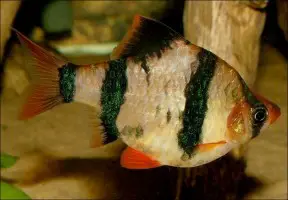
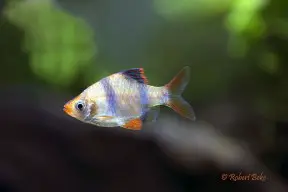
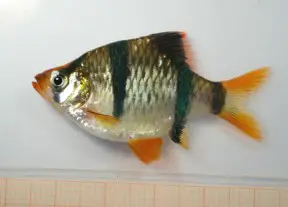
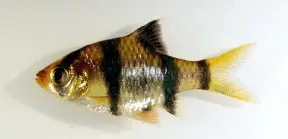

March 5th, 2013 at 6:05 pm
The correct name is Barbus anchisporus. Tetrazona has black fins, and is almost unavailible in the aquarium trade.
For Polish speaking here’s the article.
http://krytykaakwarystyczna.wordpress.com/2012/12/17/brzanka-sumatrzanska/
March 5th, 2013 at 7:04 pm
Hi Sverting check out our blog on this subject here:
https://www.seriouslyfish.com/its-often-said-that-a-tiger-never-loses-its-stripes-but-what-about-its-name/
As far as I’ve been able to work out this species is currently of uncertain generic placement as per reference #7 above, while Barbus tetrazona is a synonym of Puntius rhomboocellatus Koumans 1940.
March 5th, 2013 at 7:13 pm
The author of the article went back as far as to 1842 reading the copies of original statements. So basicly P. tetrazona should look like this:
http://krytykaakwarystyczna.wordpress.com/2012/12/17/brzanka-sumatrzanska-puntius-tetrazona-najbardziej-pokrzywdzona-ryba-w-historii-akwarystyki-czyli-ciag-dalszy-w-krainie-brzanek-czesc-1/puntius-tetrazona-bleeker/
Anchisporus like this:
http://krytykaakwarystyczna.wordpress.com/2012/12/17/brzanka-sumatrzanska-puntius-tetrazona-najbardziej-pokrzywdzona-ryba-w-historii-akwarystyki-czyli-ciag-dalszy-w-krainie-brzanek-czesc-1/puntius-anchisporus-vaillant/
And the rhomboocellatus like this:
http://krytykaakwarystyczna.wordpress.com/2012/12/17/brzanka-sumatrzanska-puntius-tetrazona-najbardziej-pokrzywdzona-ryba-w-historii-akwarystyki-czyli-ciag-dalszy-w-krainie-brzanek-czesc-1/puntius-rhomboocellatuskoumans-puntius-pentazona-tetrazona-bleeker-1857/
He used mostly old publishing:
Natuurkundig Tijdschrift voor Nederlandsch Indië
Atlas Ichthyologique des Indes Orientales Néêrlandaises
Résultats zoologiques de l’expédition scientifique Néerlandaise au Bornéo central
and some info that were published later, like the Vaillant statement, that there was a mistake in his original description.
March 5th, 2013 at 9:57 pm
Ok, read the article with the help of John (Google), but I don’t understand the author’s conclusions? Could you summarise them please?
March 6th, 2013 at 2:23 pm
There is a second article to come. Basicly the whole problem exists in the books since Vaillant misinterpreted his own work, and made some mistakes. Since then almost every information about P. tetrazona had incorrect information.
The article was written to show the errors in Polish books about the aquarium hobby.
From what I know writer (who I know as “Killifish” from the cichlidae forum) is currently in possesion of the actual P. tetrazona and is trying to breed them. The following article should be about them specificaly.
Summary is to be written before the end of the month.
I could give him Your email, if You want.
March 6th, 2013 at 2:44 pm
P. tetrazona was described by Bleeker although Vaillant did describe P. anchisporus, but I’m unable to comment further on the article without the requested summary.
Did you read the blog I linked to?
Also see the following:
https://www.seriouslyfish.com/species/puntius-anchisporus/
https://www.seriouslyfish.com/new-tiger-barb-discovery/
March 9th, 2013 at 3:46 am
I think we can safely say that the tiger barb in not P. tetrazona. I’ve even looked at the types, and can confirm this. The real question is, however, what it really is.
As mentioned in the blog post, the tiger barb does not conform to P. anchisporus either, despite looking very similar—that species has a complete lateral line while the tiger barb does not.
If SF were to change the name, what would it be changed to? There is no evidence here, so I can’t see the value in changing a well established name until this gets cleared up.
December 28th, 2015 at 10:15 am
The real P. tetrazona is quite distinct from Anchisporus , Partipentazona and Navjotsodhii , Navjotsodhii does have similar qualities to the fish we see traded as the Tiger Barb ?
P.tetrazona has got a look of P. pulcher with it’s dark ventral fins but I’d say it is a more variable fish colour wise than Pulcher and for me Bleekers illustration of Tetrazona is pretty damn good , Steven Grant has pics of a male and Female Tetrazona which he took on a visit to my house ,might be worth using here at SF !
December 30th, 2015 at 12:40 pm
Thanks for the tip and info Andy, will give him a shout. Personally think that both P. anchisporus and P. navjotsodhii show some similarities with the cultivated fish, but who knows!
December 30th, 2015 at 2:05 pm
Andy, thanks a million. Steve’s pics of your beautiful examples have now been added here. 🙂